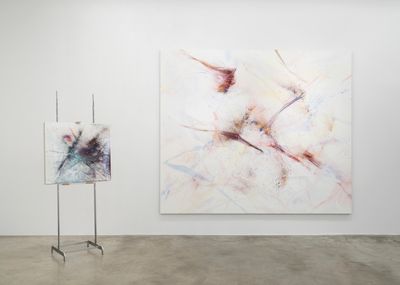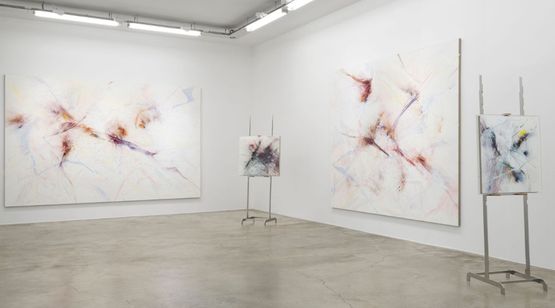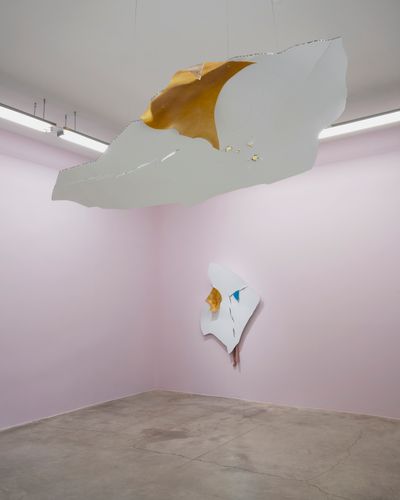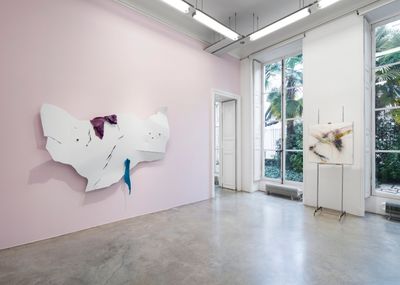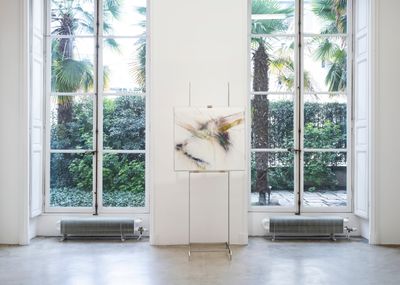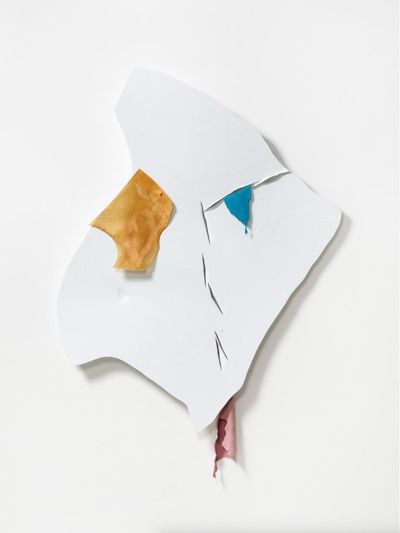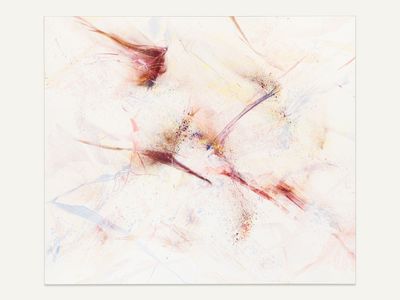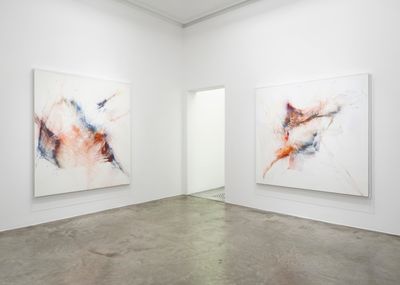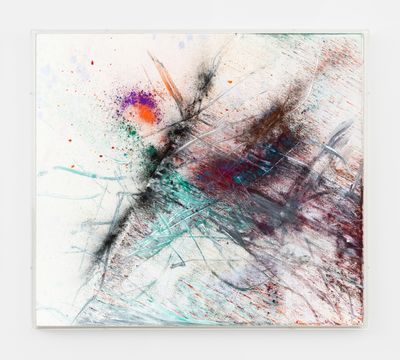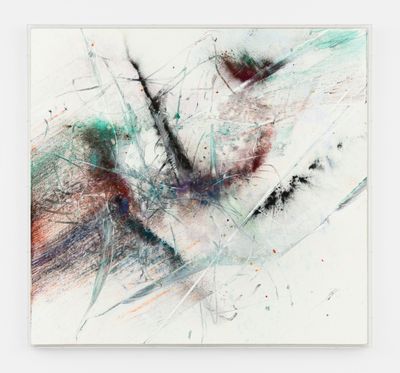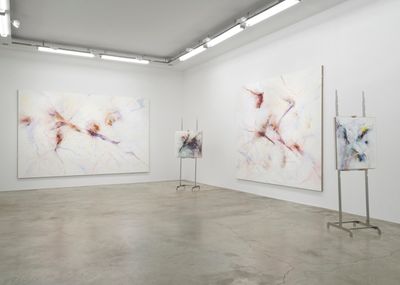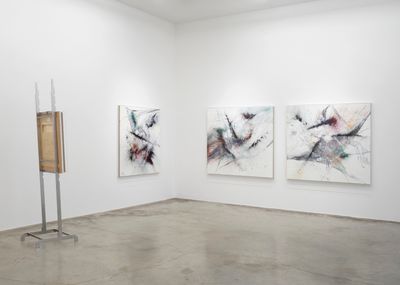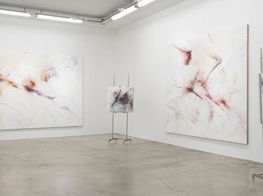Thilo Heinzmann on Embracing the Surface
SPONSORED | PERROTIN
Thilo Heinzmann. Photo: Roman Maerz.

Thilo Heinzmann. Photo: Roman Maerz.
The only thing Thilo Heinzmann ever wanted to be was an artist. He was already skilled in figurative painting when he entered the Städelschule in Frankfurt in 1992, but he came to school to pursue abstraction.
Heinzmann studied with Thomas Bayrle, befriended Haegue Yang and Thomas Zipp at the school, and worked as an assistant to Martin Kippenberger, putting his figurative painting skills to use while rejecting them in his own work.
Bayrle's youngest master student—completing the programme in just five years—Heinzmann was making breakthrough works even before leaving school. Between 1993 and 1994, he made the first of his chipboard paintings and his signature Pigment Paintings, which experiment with different ways of working with the surface of a painting. Heinzmann wanted to go beyond the canvas and wooden stretcher, and employed a variety of materials—pigments, gold dust, glass, honeycomb aluminium, leather, fabric, yarn, and fur—to explore existential space with a fascination for substances related to nature and humanity.
Heinzmann's current solo exhibition What do you want me to bring you : I am going to town at Perrotin in Paris brings together recent Pigment Paintings, which can be divided into three bodies of work. One group consists of three large paintings with bursts of colour and lively lines that trail across the white canvas. Blurry spots of yellow hint at the sun, shining through turbulent skies. The remaining Pigment Paintings, encased in Plexiglass, are mounted on the walls or, in the case of smaller works with a darker colour palette, rest on custom-made easels.
Punctuating the exhibition space are Heinzmann's Aicmo paintings, created on shaped honeycomb aluminium structures. With a nod to Lucio Fontana's perforated canvases, Heinzmann cuts and punctures the surface to change the painterly mark-making into something more physical, adding pieces of coloured parchment and leather rather than pigment to the aluminium.
A large Aicmo is suspended from the ceiling in the first room of the gallery, just above the entryway. Yellow parchment creates a swath of colour on its white surface, emitting a sunny hue from the back through the punched holes. Heinzmann changed it from a wall piece for the show, placing its face-like structure downwards to welcome visitors into the exhibition unfolding below.
Two more Aicmo works are hung on pink walls that modify the usual white box ambience of the gallery space. One has a chunk of yellow parchment looking like a bruised eye, while a piece of blue leather seeps from a gash and bits of pale pink leather peeks through the multiple cuts on one side. The other, with splashes of burgundy and blue leather, resembles a battered ghost floating in the next room.
In this conversation, Thilo Heinzmann talks about the making of Pigment Paintings, his fascination with materials and mark-making, and the implicit reciprocity of the statement, 'I am going to town.'
PLHow did you return to making Pigment Paintings after experimenting with different surfaces and materials for the realisation of a painting for more than a decade after leaving school?
THI was experimenting with works for every new show and then I got a visit from New York. Stefania Bortolami came to visit me in my studio in Berlin. I didn't have many Pigment Paintings left from the Frankfurt period—not many had survived because they were so delicate, but there was still one on the studio wall. We were talking and she said that if I could continue making paintings like this, she would give me a show in her gallery in New York. And I said, 'Stefania, when would you give me the show?' And, she made me a really generous offer, so I started again with these paintings.
PLThat's very interesting. It shows how luck can play a part in what we do.
THYes, that's right. I honestly believe without that conversation we wouldn't be having this conversation today.
PLWere you aiming at something more expressive or more cerebral?
THI can tell you what I like. If it's not expressive, I immediately get bored. But if it's too expressive, I immediately get bored. It's a combination of the two.
PLWhat's your fascination with materials?
THNature in a sense is the biggest creator of material. But I'm also fascinated by us humans. I like us, I like what we invent. I try to include different kinds of material in my language by reducing it to essential elements. Surely, it was important for me to take a further step with Aicmo from the paintings of Fontana. I took a different approach through the materials I have chosen. How can I change the mark-making into another painterly way? Therefore, I needed something that was absolutely flat and stable, even if you punched it with a high, high energy. That's why I chose the honeycomb aluminium. I'm interested in honeycomb structure. I include it in the language.
PLThe honeycomb structure has its roots in the Zero Movement with Heinz Mack. Mack bought it on Canal Street in New York when he first used it.
THYes, you are right, but I believe he thought of it as an open light reflector and used it that way.
PLDo you see your accumulated use of materials in Aicmo, such as parchment or leather attached to the honeycomb aluminium, as an assemblage or a painting?
THSurely, as a painting. Of course, each detail comes out of an ongoing process of transformation of a basic idea. Assemblage is existing. It's wonderful, but it's far away from what I'm doing.
PLFor me, I see the leather and the parchment as another form of mark-making, almost like it's a solid bit of colour, like in a Helen Frankenthaler painting. I see your attachment to materials like adding another colour, another way of mark-making.
THYes, that is right on one side. That is absolutely right. Let me extend it a little bit. You mentioned Helen Frankenthaler, then as the painter I am, I'm thinking about exactly that process. It's not just the pouring, it's also the form, the movement, the body comes into it. I collect colours from all over the world. I look at it and then I cut it. That is part of it. By having it around me and spending time with it—with all of these things—I, hopefully, understand them a bit better and then the materials find their way into the work with another form of reason.
PLWhat were you trying to achieve with Pigment Paintings?
THI made the first one around 1993 or 1994, when the computer came into the artist studio and into the university—especially into the school where I was a student. I didn't have a computer, but I saw it and was confronted with it. I was actually fascinated by it—with how you could choose colour by pointing at something and putting it somewhere, and you could point again and soften it. Right at that time, Jorge Pardo came to the school from Los Angeles. He was much more knowledgeable with computers than we were at that time. He had a better understanding of them. He lived with the computer in a different way.
I decided that I wanted to find a way to respond to the machine in painting, in a way that hadn't been done. I wanted to be different, I wanted to be new, but not in the way of a computer. I was extremely interested in being fast and then I came to the idea of changing the surface of my canvas by applying different forms of primer. I applied oil with a brush, but then I rolled it. By the process of rolling, I changed the surface into this chaotic code, which had another advantage. By rolling it, I created mountains and valleys, which increased the ability of the surface to act like glue. And that enabled me to paint with pure pigments, to make colour free of these binding processes of chemicals, water, oil, or whatever—in an open and fast process.
It was a way to create a new form of painting. Then I continued and changed the process to include parts of my other ways of working. They now include parts of the Styrofoam paintings. They include parts of Aicmo. They include parts of the squeegee brush-process, and they also include changing the surface, light reflections, by applying different forms of glass structures on it.
PLAre Pigment Paintings pre-planned?
THYes, it's a pretty concentrated process. Um, and I have to prepare everything in advance. I now mix liquid colours, which I combine, and they are also mixed from different pigments. So, there's an organised pre-process which was not there in the past on that level. In the past it was concentrated purely on colour. I also prepare the glass.
PLIs there an action and then a reaction?
THYes, but the action is the main thing. And, when there comes a reaction, you are lucky, because this you cannot plan. This you achieve as a gift. It's a gift, which does not always happen. Sometimes it happens, and then again, another action follows.
PLDo you use different tools when you're making these paintings?
THYes, I have about 30 different brushes. I made some of them myself and some were custom made. I have different sizes, up to 1.2 metres. I use squeegees, too. And I use my hands and my arms, but these are secrets, which I shouldn't be sharing.
PLI've read that you use assistants to help you shift the canvas around while painting it, and that you do this outdoors in a garden. Is that true?
THYes, you are right. For the past 14 years I've worked with two painters who help me move the canvas around. I am very grateful for their precious help. Over the years, we've developed a silent language, a way of communicating, which enables me to paint in the way I do. All of Pigment Paintings are made outdoors.
PLDoes the wind play a factor?
THYes, absolutely, that's one of the reasons I make them outdoors.
PLIt's interesting because that makes me think of John Cage and his use of the element of chance, as well.
THYou are right. And this was a great inspiration. But you know how it was used or interpreted by Gerhard Richter? He said that was an important influence for him. It was at a time when he was friends with Sigmar Polke, who interpreted it differently and never talked about it the way Richter did. I'm much more into the interpretation of Polke. I would say it is a big advantage when you are able to see yourself as a very small element in the whole picture. If you are lucky, this wouldn't do you any harm—instead it gives you a certain kind of pleasure. But that is something you cannot ask for.
PLIs the process shamanistic?
THAgain here, we have to be very careful. When I heard the interpretations of Polke's work in America—especially with a particular New York show, where the paintings had this alchemistic, shamanistic level—I found it misleading. What's always missing is how important it was for all of them—after the horrible war— that they could go back to Dada. That they could go back to something that tries to include life with both humour and despair. So, I would not see myself in the direction of, let's say, Surrealism. I would always say no, it's Dadaism. Therefore, I would not talk about shamanism. I would say there is a love and—hopefully—a clear, acquired understanding of materials and the drive to find new ways to combine these materials. I am a realist believing in miracles.
PLIs your mark-making primal?
THI think if the artist himself does not want to be in a painting, then he's missed the point. And I'm not talking about conceptual art. I'm talking about painting, about a painting that's so interesting that you are in there.
PLIt's not conceptual art. It's different. It's the mind and hand working in harmony.
THYes.
PLAre you attacking the surface or caressing it?
THNo, I would say I'm embracing it.
PLBut when you're making cuts and punching holes in the honeycomb aluminium, do you have to forcefully use tools?
THIn making the Aicmo works, I use tools I made myself, and I use special tools. I have to achieve a level of concentration, just like when using brushes. I wouldn't go into a violent action; it's more of a concentrated action.
PLSo, it's different from, say, the action of Karl Appel, attacking the canvas with a spatula loaded with paint, right?
THYes, and it's also quite different from the Gutai artists. A lot of it has to do with where we are at a moment in time and what happens.
PLIs it a performative action like Georges Mathieu or more of a meditative one like Hans Hartung?
THIt's surely in the direction of Hartung, after all I'm German. I'm more interested in what Fontana did and, in a different way, in what Mark Tobey did. I'm a fan of Tobey. So, Hartung, yes. Tobey, yes. K.O. Goetz, yes. All of these, yes, yes, yes... but all together.
PLDo you present Pigment Paintings encased in Plexiglass to protect their surface or to objectify them?
THWhen I first made them, I couldn't afford to encase them. They came back nearly destroyed from every show because people touched them. It was a relief when I was finally able to encase them in Plexiglass. It was necessary to keep them intact, to preserve them. But then that element, the element of objectifying them came into play, too. I have nothing against it, but it wasn't something that I planned.
PLWhat role do the custom-made easels play in your exhibitions?
THThey play a role... It is about how you can use furniture, in general, to create a situation, especially when it comes to a show of paintings. It can give a structure, a resting point, to maybe give an idea of a position of contemplation. In this sense the easels are furniture. But I tried—in the way I designed them—to make them also a bit human. They are figures, they're visitors, who bring you something.
PLAnd what is the title of the exhibition, What do you want me to bring you : I am going to town, meant to imply?
THFirst, it is an idea where we can discuss town versus, let's say, the countryside. I make the decision clear that I'm going to town because I think that's what we should do.
PLLeaving the city for the countryside is often an escape from solving society's problems.
THYes, exactly. It's important for me, as an artist, to take part in society. And then, there's another element to consider: to bring something is a kind way of talking about your offer. This is what I'm doing.
PLIt's what the farmer does from the countryside. He brings something to the market.
THYes, and I do the same as an artist. But the title also talks about the opposite direction: I don't just bring something to town, I also bring something back from town. It's about an exchange in both directions. —[O]
Thilo Heinzmann's solo exhibition What do you want me to bring you : I am going to town at Perrotin, Parris, closes on 6 April 2024.



